Overview
This article underscores the critical importance of grasping noise pollution safety standards within the realm of land acquisition. It highlights how noise disturbances can adversely affect property values and compliance with regulatory frameworks. Thorough noise assessments and strict adherence to safety standards are not merely advisable; they are essential for navigating successful land acquisition processes. By mitigating legal risks and fostering positive community relations, these practices ultimately enhance project feasibility. Understanding these dynamics is not just beneficial—it is imperative for stakeholders aiming to secure their investments and ensure regulatory compliance.
Introduction
Noise pollution stands as a significant challenge in the realm of land acquisition, impacting buyer interest and regulatory compliance alike. As urban areas expand and industrial activities increase, communities increasingly experience the detrimental effects of unwanted sound. This reality compels a reassessment of how noise levels influence property values and development initiatives.
With a substantial segment of the population exposed to noise pollution daily, stakeholders must adeptly navigate a complex array of safety standards, legal regulations, and community expectations. This article examines the intricate relationship between noise pollution and land acquisition, highlighting the critical need for:
- Comprehensive noise assessments
- Effective mitigation strategies
- An awareness of evolving regulations
Such knowledge is essential for ensuring successful project outcomes and fostering community well-being.
Define Noise Pollution and Its Impact on Land Acquisition
Noise contamination represents a significant challenge, characterized by undesirable or damaging sound levels in the environment, primarily stemming from industrial operations, transportation, and urban development. In 2025, a striking 83.9% of participants reported experiencing daily sound disturbances, underscoring its widespread prevalence and impact. This environmental concern profoundly influences land acquisition processes by jeopardizing the health and well-being of nearby residents, potentially resulting in legal disputes and heightened regulatory scrutiny. Elevated sound conditions may deter prospective buyers or investors, complicating negotiations and inflating project costs.
Furthermore, sound disturbances often lead to compliance issues with local zoning ordinances and environmental regulations, necessitating thorough evaluations of sound levels to ensure adherence to noise pollution safety standards during site selection. For instance, a study conducted in Enugu Urban highlighted the urgent need for comprehensive urban management strategies to address auditory disturbances, advocating for the establishment of noise pollution safety standards and public awareness initiatives. These measures are vital for improving residents' quality of life and facilitating smoother land acquisition processes.
As Adam Hubbard, a Senior Wealth Strategist, aptly noted, "This kind of instability is not just inconvenient; it's a serious threat to portfolio performance." By grasping these implications, stakeholders can make informed decisions and develop effective strategies to mitigate noise-related challenges in land acquisition negotiations, ultimately safeguarding property values and enhancing tenant satisfaction.
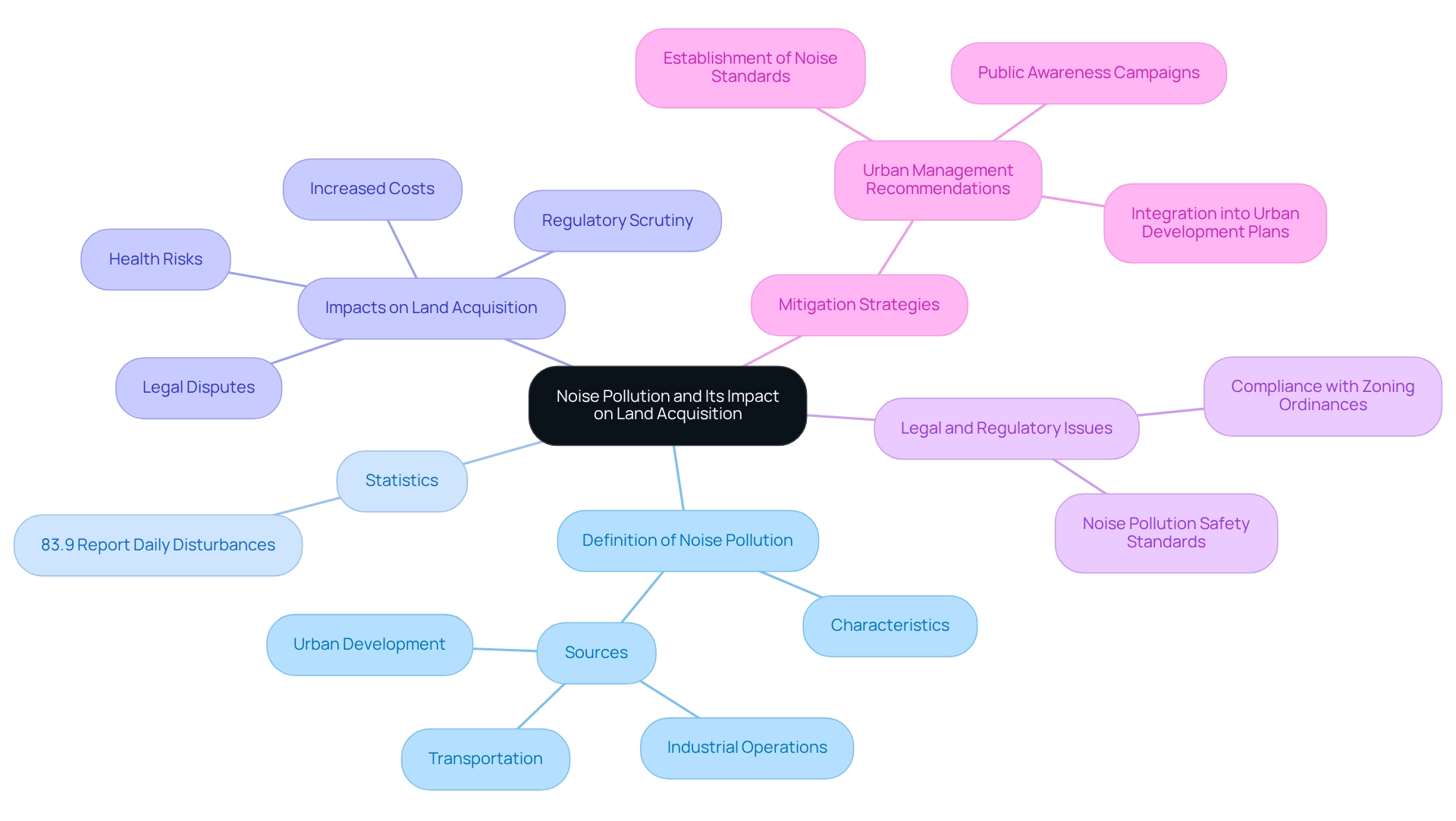
Explore Noise Pollution Safety Standards and Regulations
Noise pollution safety standards and regulations are crucial for safeguarding public health and welfare, showing significant variation across different jurisdictions. In the United States, the Environmental Protection Agency (EPA) sets criteria for permissible sound intensities, which play a crucial role in land acquisition procedures. Municipalities often enact regulations that establish maximum permissible sound levels during designated hours, particularly in residential areas. These local regulations can vary significantly; for instance, the UK enforces an 87 dBA limit for an 8-hour time-weighted average, while Germany adopts a stricter 85 dBA threshold.
Adhering to these standards is imperative, as non-compliance can lead to substantial fines, delays, or legal repercussions. Developers are advised to conduct thorough sound evaluations and engage with local authorities early in the planning process. This proactive approach not only ensures compliance with safety standards but also cultivates positive community relations and enhances project acceptance.
Consider this: a mere 5 dB reduction in sound levels could yield an estimated annual economic benefit of $3.9 billion. This statistic underscores the financial incentives for implementing effective sound reduction strategies. However, challenges in securing funding for research on the health impacts of chronic low-level sound exposure continue to hinder progress in this essential domain. Historically, significant environmental groups have concentrated on air and water pollution, often neglecting sound issues, which has obstructed comprehensive research and policy development. As the landscape of land acquisition evolves, understanding and complying with current noise pollution safety standards will be crucial for successful project execution. Are you prepared to navigate these complexities and ensure compliance in your next project?
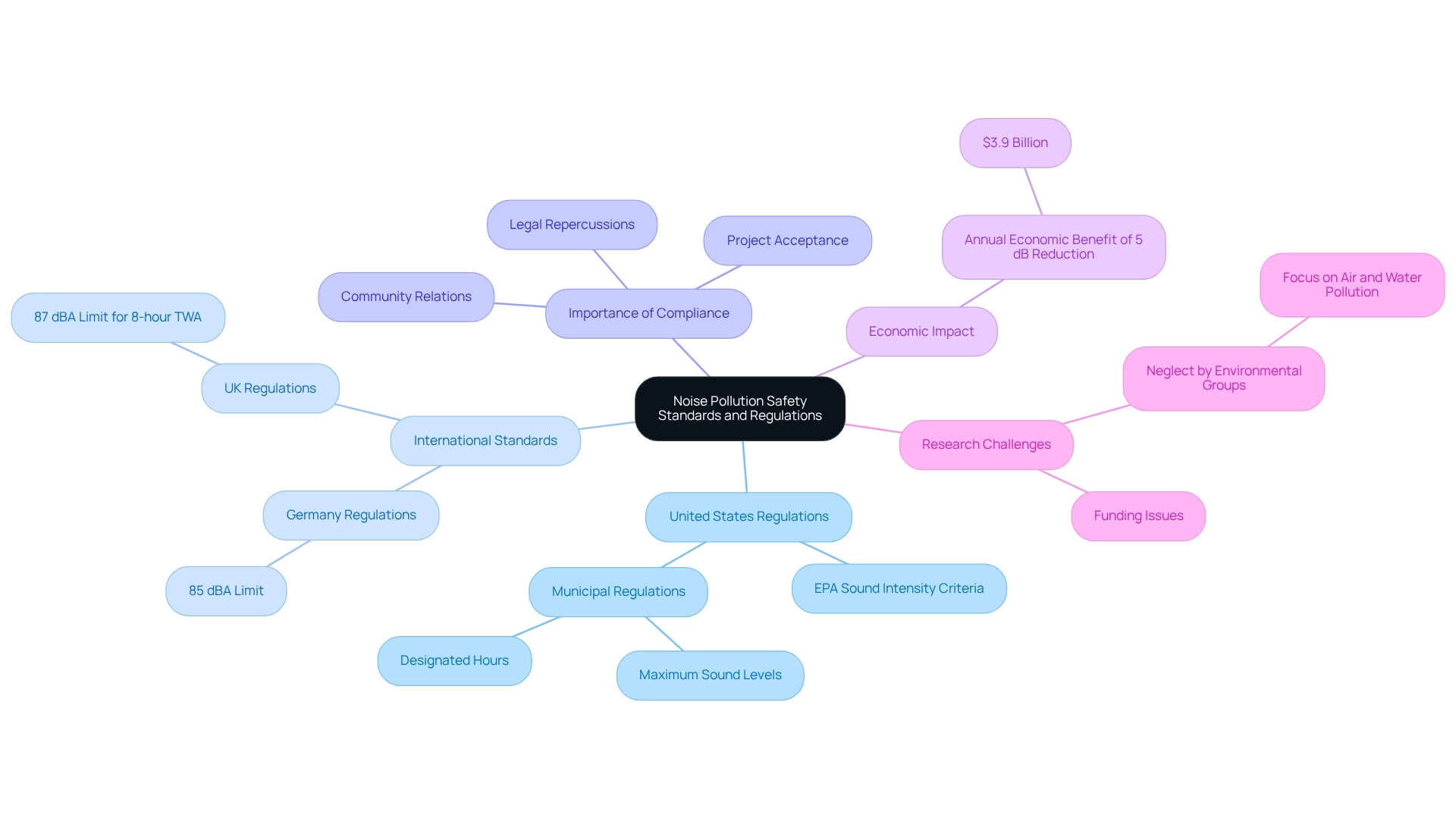
Conduct Noise Assessments During Site Selection
Performing sound evaluations during the site selection phase is crucial for understanding current sound intensities and predicting future impacts from proposed developments. This process combines on-site measurements, advanced computer modeling, and comprehensive analysis of existing data. By identifying sources of disturbance and their potential effects, developers can make informed decisions about site suitability and necessary mitigation strategies. For instance, sites located near busy highways frequently require sound barriers or other noise-reducing designs to comply with noise pollution safety standards and promote community acceptance. Engaging acoustic consultants can significantly enhance the accuracy of these assessments, as they possess the expertise to interpret data and recommend effective mitigation measures.
Recent studies indicate that the inclusion of additional predictor variables markedly improves traffic sound predictions, with models such as XGB and CadnaA demonstrating effectiveness for motorway sound levels. The research titled 'Future Directions for Traffic Sound Modeling' proposes that exploring advanced neural network models and incorporating temporal variables can further refine sound predictions, addressing the increasing concerns related to traffic-induced sound pollution. Abdullah Alamri underscores the importance of these methodologies in his research on traffic sound modeling, asserting that they yield more precise evaluations. These methodologies not only facilitate compliance with noise pollution safety standards but also play a vital role in enhancing the overall feasibility of land development initiatives.
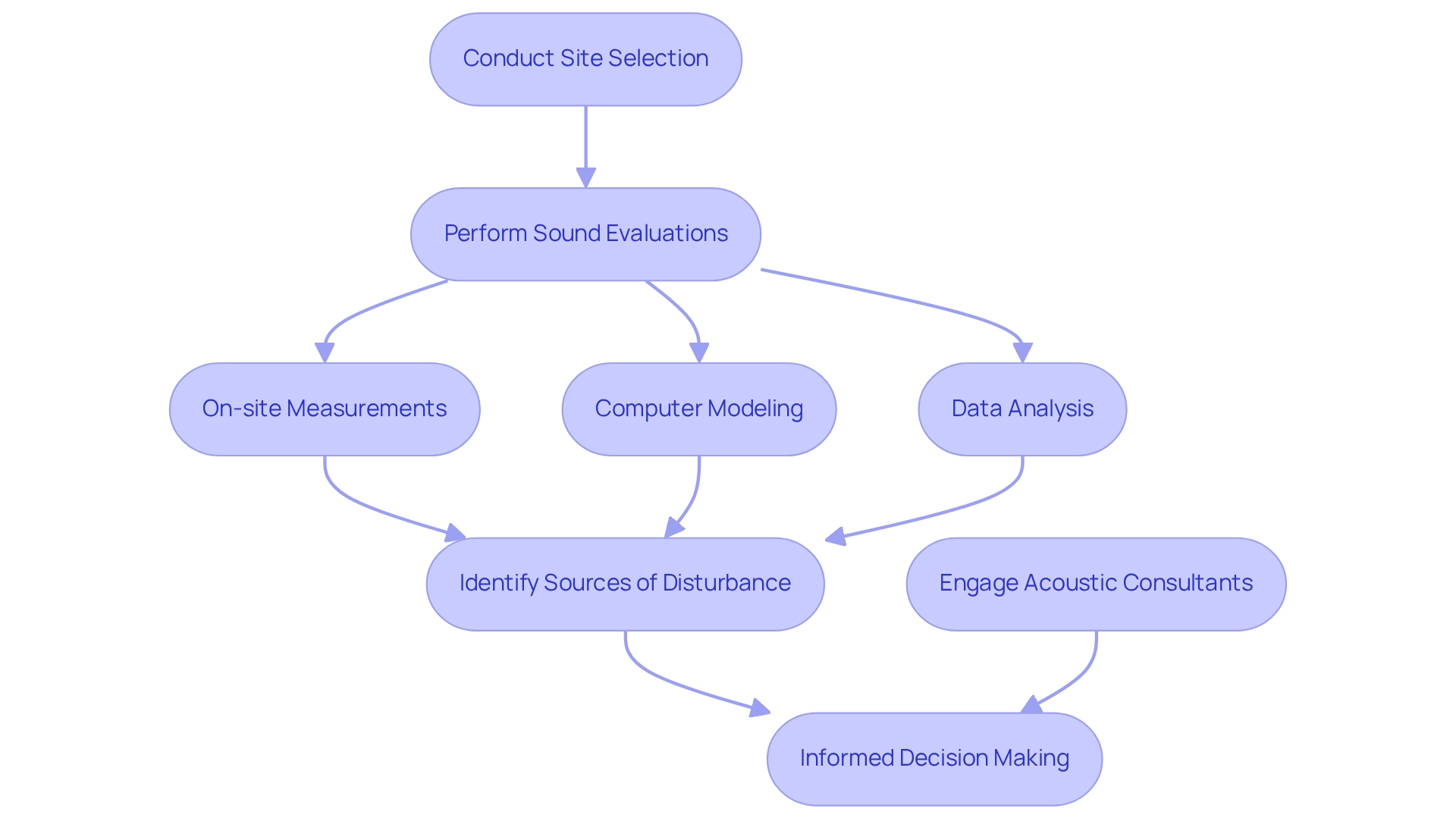
Implement Mitigation Strategies for Noise Pollution
Implementing effective sound reduction strategies is essential for enhancing the feasibility of land acquisition and ensuring successful project development in accordance with noise pollution safety standards. Key strategies encompass:
- Designing buildings with soundproofing materials
- Establishing buffer zones through landscaping
- Erecting sound barriers
Additionally, scheduling construction activities during off-peak hours can significantly minimize disturbances to nearby residents.
Community engagement is vital in these efforts. Developers must actively communicate their sound management plans and address local stakeholders' concerns, fostering transparency and trust. As emphasized in the case study titled "The Importance of Early Planning in Sound Mitigation," early consideration of sound pollution leads to more effective solutions, ultimately enhancing indoor environments and benefiting occupants. For instance, incorporating sound management strategies from the outset can greatly improve outcomes.
Statistics indicate that adhering to ANSI S12.60 section 5.4, which provides minimum Outdoor-Indoor Transmission Class (OITC) ratings for walls and roofs based on external sound levels, can assist developers in selecting suitable materials and designs that comply with noise pollution safety standards. By proactively addressing disturbances, as highlighted by ROCKWOOL Technical Support Services, developers can cultivate positive relationships with the community, thereby reducing the likelihood of resistance to their projects. While there is no universal solution for preventing sound disturbances, considering the use of space and potential sound sources early in the planning stage serves as a beneficial starting point.
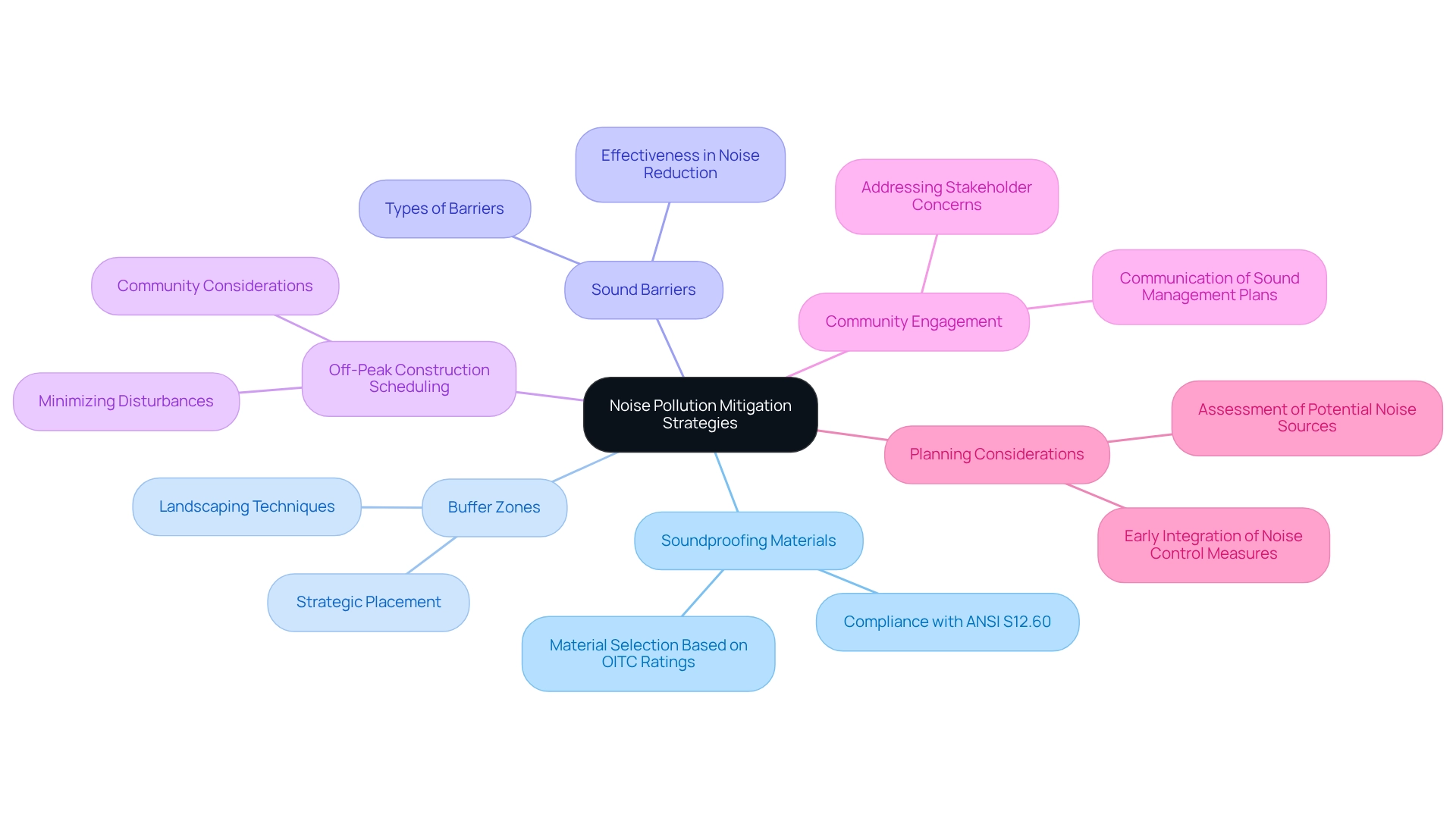
Stay Informed on Evolving Noise Regulations
Noise regulations, which include noise pollution safety standards, are continually evolving, driven by emerging research and shifting community standards. Developers must actively monitor these changes to maintain compliance and mitigate potential legal risks. Frequent discussions with legal specialists are essential, as they provide insights into the latest noise pollution safety standards and assist in navigating the complexities of the regulatory environment. Additionally, participation in industry associations offers valuable resources and networking opportunities to stay informed about updates from regulatory agencies.
Interacting with local communities is equally important, enabling developers to assess public sentiment regarding sound pollution. Understanding community concerns helps anticipate future regulatory shifts while fostering positive relationships with stakeholders. Recent studies indicate that socially and economically disadvantaged communities often face higher levels of environmental disturbances, underscoring the need for tailored strategies to reduce such impacts. For instance, the case study titled "Variability of Sound Exposure and Health Implications" highlights the potential health effects of environmental sound and the variability of exposure based on socioeconomic conditions. This suggests that future research should incorporate personal sound dosimetry to better evaluate exposure disparities.
As Jane Austen wisely stated, "Every individual has their preference in sounds as well as other aspects; and sounds are quite harmless, or most troubling, by their type rather than their amount." This quote underscores the subjective nature of auditory perception, reinforcing the necessity for developers to consider community sentiment in their compliance efforts. As of 2025, developers must remain vigilant about the latest updates in sound regulations, which increasingly emphasize the protection of vulnerable populations and align with noise pollution safety standards, particularly those represented by the hardship index with a median value of 8.51. By adopting a proactive and adaptable approach, developers can effectively navigate the complexities of noise regulations, ensuring compliance while enhancing the success of their land acquisition efforts. This strategy not only safeguards projects from legal challenges but also contributes to the overall well-being of the communities they serve.
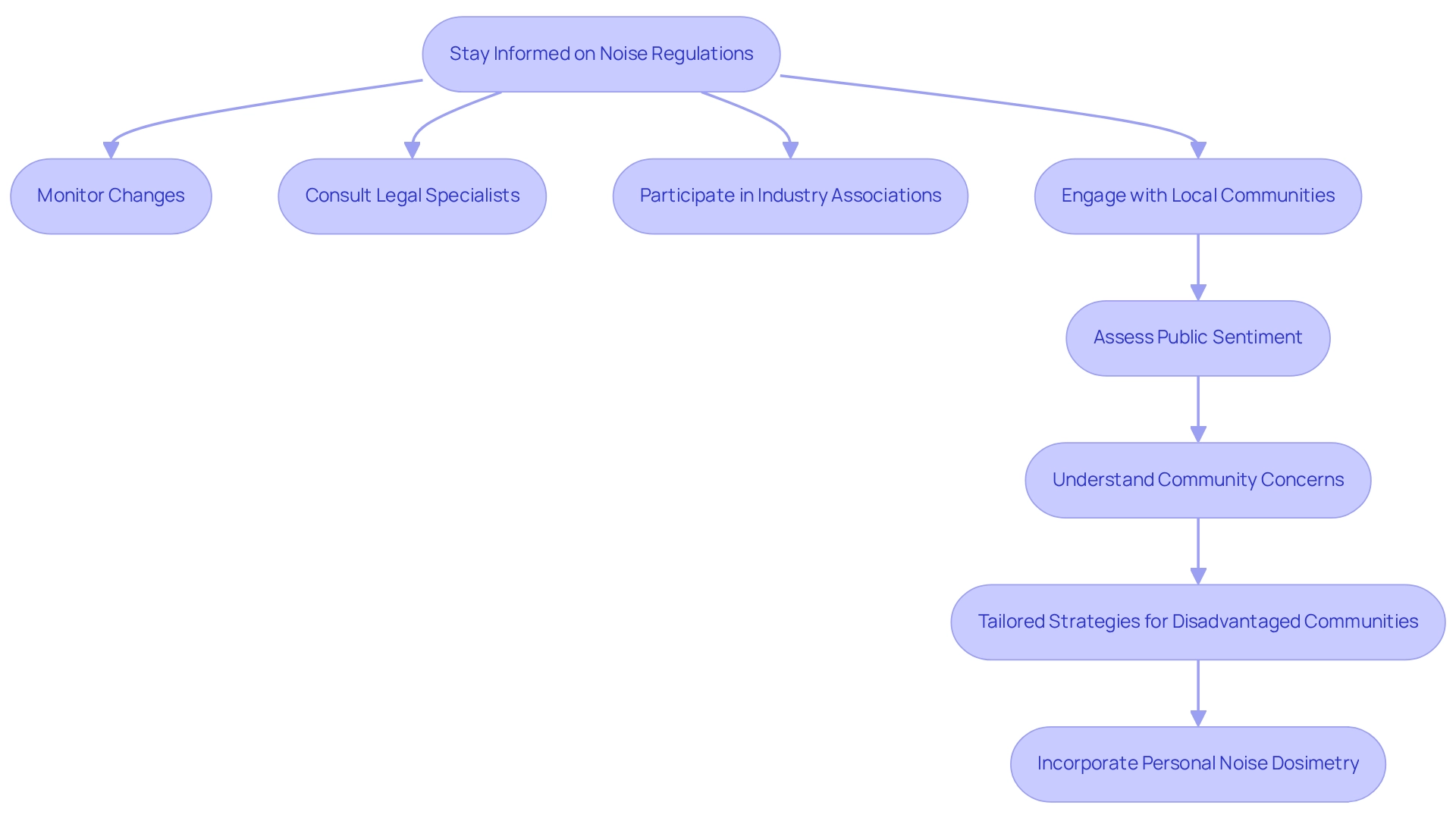
Conclusion
Noise pollution presents a formidable challenge in land acquisition, significantly impacting buyer interest and regulatory compliance. It is essential to recognize the multifaceted effects of noise pollution, which necessitates comprehensive noise assessments, the implementation of effective mitigation strategies, and an awareness of evolving regulations. Understanding the implications of noise on property values and community well-being enables stakeholders to navigate the complexities of land acquisition more adeptly.
Adhering to noise safety standards is paramount; compliance is crucial for avoiding legal repercussions and fostering positive community relations. Engaging with acoustic consultants and employing advanced modeling techniques can significantly enhance noise assessments, leading to well-informed decisions during the site selection process. Furthermore, targeted noise mitigation strategies, such as soundproofing and community engagement, are vital for ensuring project success and improving residents' quality of life.
As the regulatory landscape surrounding noise pollution evolves, developers must remain vigilant and proactive in monitoring changes. By fostering open communication with local communities and addressing their concerns, stakeholders can anticipate regulatory shifts and enhance project acceptance. A thorough approach to managing noise pollution not only safeguards property values and project viability but also contributes to the overall well-being of the communities involved. In an era where urban development is increasingly prevalent, considering noise pollution in land acquisition is not merely an obligation; it is a critical component of responsible and successful development practices.
Frequently Asked Questions
What is noise contamination and where does it primarily come from?
Noise contamination refers to undesirable or damaging sound levels in the environment, primarily stemming from industrial operations, transportation, and urban development.
What percentage of participants reported experiencing daily sound disturbances in 2025?
In 2025, 83.9% of participants reported experiencing daily sound disturbances.
How does noise contamination impact land acquisition processes?
Noise contamination jeopardizes the health and well-being of nearby residents, potentially leading to legal disputes, heightened regulatory scrutiny, and complicating negotiations, which can inflate project costs.
What are the implications of elevated sound conditions on prospective buyers or investors?
Elevated sound conditions may deter prospective buyers or investors, complicating negotiations and inflating project costs.
Why are noise pollution safety standards and regulations important?
They are crucial for safeguarding public health and welfare, ensuring compliance during land acquisition processes, and preventing substantial fines, delays, or legal repercussions.
How do noise pollution regulations vary across different jurisdictions?
Regulations can vary significantly; for example, the UK enforces an 87 dBA limit for an 8-hour time-weighted average, while Germany adopts a stricter 85 dBA threshold.
What is the financial benefit of reducing sound levels by 5 dB?
A 5 dB reduction in sound levels could yield an estimated annual economic benefit of $3.9 billion.
What challenges exist in researching the health impacts of chronic low-level sound exposure?
Challenges include securing funding for research, as significant environmental groups have historically focused on air and water pollution, often neglecting sound issues.
What proactive measures should developers take regarding sound evaluations?
Developers are advised to conduct thorough sound evaluations and engage with local authorities early in the planning process to ensure compliance with safety standards and cultivate positive community relations.




